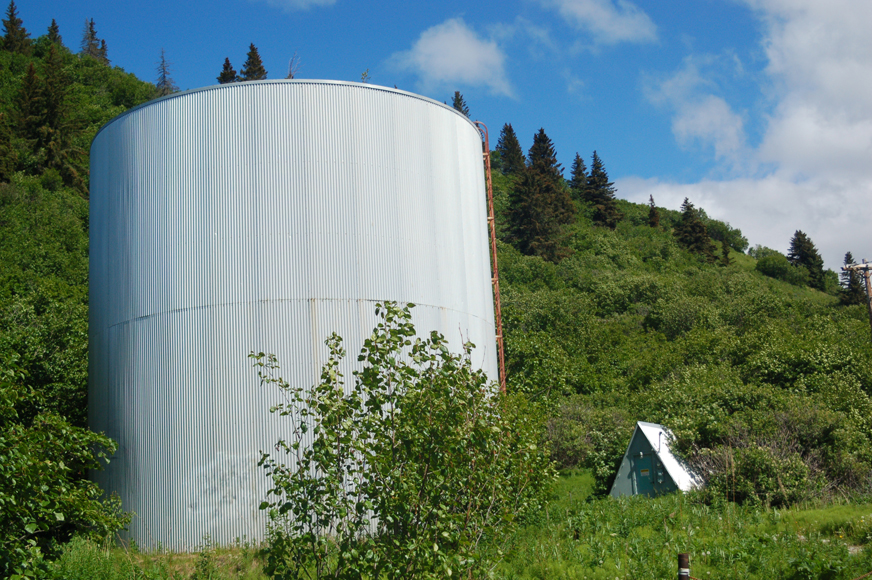Editor’s note: With 2014 marking the Homer News’ 50th anniversary, the newspaper is looking at some milestone events in Homer’s past.
At the top of Main Street on Dehel Avenue a big water tank stands above the little white picket-fence park, Bayview Park. Next to the 250,000-gallon tank is a small A-frame building, a pressure reduction vault. Like many utilitarian civic structures, it might go unnoticed. Since October 1966 when the tank was completed, the A-frame tank — named so for the building next to it — day in and day out for almost 48 years has served Homer with something many take for granted: clean, drinkable water.
The city of Homer long ago moved out of Town Hall in the Dufour Building at the corner of Bartlett Street and Pioneer Avenue. The library has been moved several times since incorporation in 1964. The Homer Intermediate School lies abandoned, with dreams of it becoming the Homer Education and Recreation Complex. The A-frame tank soldiers on, though, perhaps Homer’s oldest and continually used civic structure.
In browsing through back issues of the Homer News from 1965 to the water system’s completion in March 1967, it becomes clear that piped water back then was like building a natural gas distribution line today — a milestone civic venture. Homer News editor and publisher H.A. Thorn covered building a water system like Bob Woodward and Carl Bernstein covered Watergate. OK, maybe not as ruthlessly and of Pulitzer Prize quality, but Thorn stayed on the story. He might have had an enlightened self interest. When it came time to drill the water wells to serve the city, his company, Thorn Drilling, got the contract.
In 1965 when Anchorage engineering firm Tryck, Nyman and Hayes designed the water project, the city didn’t have a fancy water treatment plant. The A-frame tank was the treatment plant. Public Works Director Carey Meyer said the tank had two shells. The inner shell held the water and an outer shell held chlorine to purify the water. The chlorine slopped over from the outer shell into the inner shell.
“At that point, all you had to do was add some chlorine,” Meyer said.
Water came from three wells drilled in the Bridge Creek watershed. That’s still Homer’s water source, except that a dam now blocks the creek, creating a reservoir.
Thorn, whose motto for the Homer News then was “aims at progress,” promoted incorporation when the paper first came out in January 1964. Under state rules for cities, a city couldn’t create a water utility without incorporation. After citizens voted for incorporation in March 1964 just before the Great Alaska Earthquake, a water utility could move ahead. In January 1965, Tryck, Nyman and Hayes drilled a test well near Bridge Creek, hitting 500 gallons of water at 110 feet, but unfortunately high in iron. Another well at 254 to 283 found water producing sandstone with no iron.
At a council meeting then, Mayor Ralph Cowles and Frank Nyman of Tryck, Nyman and Hayes briefed the council on financing. In March 1965, voters passed two bond propositions, one to finance a revenue bond of $175,000, and one to finance a general obligation bond of $350,000. The vote for the revenue bond was 237 to 99 in favor and 213-122 for the general obligation bond. In 2014 dollars, that $500,000 total cost would be $3.7 million, according to the Consumer Price Index inflation calculator.
“The people of Homer have once again expressed their confidence in their area, their future and their leadership by solidly voting two to one for the basic water system for the city,” Thorn wrote in an editorial.
In April of 1965, customers could start signing up for water for a $50 deposit, or $376 today. The project hit a snag when the Home Housing and Finance Agency said the system as designed was too big. With some redesign, the agency approved a loan. Bids came back by December 1965, with B.B. & S of Anchorage the winning contractor. Thorn Drilling got the contract to drill three 8-inch wells, and started in March 1966. Construction on the tank started in April.
In October 1966 the outside of the tank was completed. The first business to hook up to and receive water was the Waterfront Bar and Dining in Old Town, now AJ’s OldTown Steakhouse and Tavern.
John Wythe, 52, now lead man for road operations at Public Works, lived on Main Street in the wood-frame house that’s now the Knitty Stash. A well served his house and his grandparents’ house across the street.
“We had to really watch who did what laundry when,” he said. “When the city water came on, we could do all the laundry we wanted.”
The old A-frame tank will go away eventually.
“It is deteriorating badly on the inside,” Meyer told the Homer City Council in April.
The city is now designing new facilities to replace the tank, including an underground tank to go on Shellfish Avenue off East Hill Road. The new tank will allow for the demolition of the A-frame tank.
Michael Armstrong can be reached at michael.armstrong@homernews.com.
A-frame water tank and pressure reduction vault
Location: Dehel Avenue and Main Street, above Bayview Park
Built: 1965-66 by B.B. & S. Construction, Anchorage
Engineering by Tryck, Nyman and Hayes, Anchorage
Size: 250,000 gallons
1965 cost: about $500,000 ($3.7 million in 2014 dollars)
1965 water bill: about $12 month ($90.31 in 2014 dollars)
1965 source: three wells in Bridge Creek drilled by Thorn Drilling
Water system started March 1966, completed March 1967
First business to sign up for and receive water:
Waterfront Bar & Dining (now AJ’s OldTown Steakhouse and Tavern)


